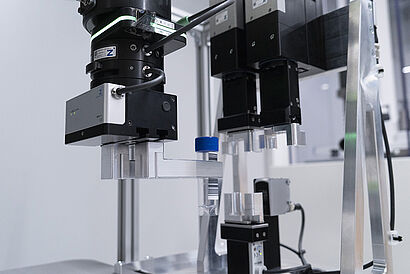Two functions, one component
The new standard gripper from the Zimmer Group has got it right
Laboratories are currently facing increasing pressure to automate: the number of samples is growing, traceability is being monitored more strictly, and cycle times are getting shorter—all while maintaining the highest level of precision. Manual steps such as screwing sample tubes open and closed, precisely aligning barcodes, or labeling vials can become bottlenecks if they are not reliably automated. Conventional grippers quickly reach their functional and design limits here.
With the new 2-jaw parallel rotary gripper of the REP2000 series, the Zimmer Group presents a component that combines gripping and turning in a single component – a well-thought-out answer to the high demands of modern laboratory automation.
Maximum functionality in a minimum of space: The compact combination of gripping and turning unit saves valuable installation space in cramped machine layouts. This is a decisive advantage when system modules need to be retrofitted or modernized. Instead of two separate modules, only one drive needs to be controlled. This reduces the amount of wiring, simplifies installation, and, last but not least, saves investment and operating costs.
Flexibility as standard: IO-Link as the key
Control via IO-Link takes the REP2000 to a new level. Users can vary the stroke of the gripping jaws to suit different vial and container diameters. At the same time, the swivel angle of the continuously rotatable unit can be precisely adjusted to the process. This means that a wide variety of container types can be opened, closed, or precisely positioned automatically without the need for mechanical modifications or long downtimes.
This flexibility is a decisive advantage for maximizing system availability, especially in laboratories where product changes or different sample batches are frequently processed.
Process reliability is also ensured in emergencies: Sample material is precious – any loss means time and money. This makes the mechanical self-locking mechanism of the REP2000 all the more important: in the event of a power failure, it holds the workpiece securely in place. An integrated emergency release allows the gripper to be opened manually so that samples can be removed quickly and safely – a safety feature that makes all the difference in an emergency.
With up to five million maintenance-free cycles, the REP2000 proves that high cycle counts and compact design are not mutually exclusive. Thanks to integrated position sensing, every stroke is monitored – this increases process quality and facilitates preventive maintenance. The REP2000 also has IP54 protection.
Specific application: faster sample throughput
The flexibility is evident in practice: in an automated sample preparation line, the REP2000 can take over the automated opening and closing of sample tubes. At the same time, it aligns the vessels precisely so that barcodes can be reliably detected. Two work steps, one component – the time savings are measurable and the process is more stable.
Conclusion: Compact solution for complex tasks
The REP2000 provides system integrators and laboratory operators with a cost-effective solution for typical automation challenges in the laboratory: less installation space, fewer components, less downtime – with maximum process reliability. For anyone who wants to make their systems fit for increasing sample numbers and flexible processing, the 2-jaw parallel rotary gripper from the REP2000 series is the next logical step.


